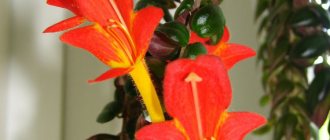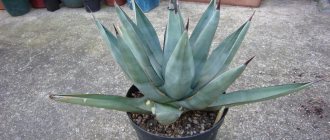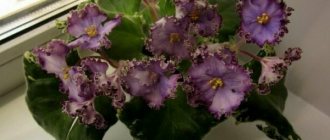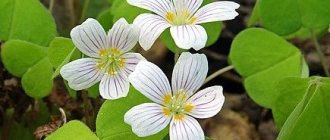In nature, calathea grows in tropical forests. Its leaves are very decorative - they are green, white, pink, violet, purple above, and dark red or purple below. They are decorated with decorative stripes and patterns. The plant has the ability to cleanse the air of toxins and harmful substances. We will tell you how to grow an indoor calathea flower - care at home, how to plant it correctly, propagate it, and show photos of interesting varieties. This rather demanding plant must be provided with high air humidity and a constantly moist substrate.
Description of the plant
The genus Calathea (lat. Calathea) is the largest in the arrowroot family. Under natural conditions, this plant is found in the tropical rainforests of South and Central America. There are more than 130 wild species of calathea, but most often no more than 20 of them are grown indoors.
The flower got its name from the ancient Greek calathos - basket, because baskets have been woven from dry calathea stems from ancient times to the present day.
Calathea is a perennial ornamental deciduous plant with underground rhizomes that form a superficial root system. Vertical shoots with rosettes of leaves extend from the rhizomes, and one rosette can contain only one fully developed leaf. The leaf blades are on long vertical petioles from 30 to 80 cm in height. The leaves are large, up to 30 cm, oval, although there are also lanceolate-leaved species. Their colors are very diverse: there are calatheas with green, red, and white leaves. All species are united by extraordinary variegation - veins and lines of contrasting color stand out on the leaf plate . Calathea blooms with small flowers collected in spike-shaped inflorescences.
Calathea foliage is very decorative
Why does a flower raise its leaves up in the evening and lower them in the morning?
Calathea has one interesting feature. In the evenings, its leaves rise up, and in the morning they fall again and turn towards the sun. This behavior of the flower is associated with the conditions of its growth in its natural environment. In its homeland in tropical forests, among thickets of other plants, the calathea has to catch every ray of light, which is why its leaves have become so mobile.
For its ability to fold and straighten its leaves, the calathea received the name “prayer flower.” There is a belief that, turning to the sun, the calathea prays for the well-being and prosperity of the house in which it grows.
Calathea is undoubtedly a very attractive plant. But in order for its foliage to truly decorate the interior, and not wither as a pathetic bush, tireless care and compliance with the rules of maintenance are required. Only experienced gardeners can grow calathea.
Calathea propagation
The plant reproduces in three ways:
1. The easiest way is to divide the bush. This can be done when replanting it by dividing the plant into several parts. When each of them has a growing point and a good root system, the bush will definitely take root. Sprinkle any damage that occurs when dividing the bush with charcoal.
2. Cuttings are not always successful, because, having a growth point, the rhizome still needs to be grown. Place the cutting in a moist substrate and cover it with a transparent cap, creating greenhouse conditions for it. Remove the hood daily for ventilation. Just like cuttings, propagation is carried out by leaf.
3. Seed propagation is the most difficult method of propagation. Seeds usually don't germinate well and seedlings don't grow very well. Seeds need to be disinfected in a 1% solution of potassium permanganate. Then sow them on the surface of the soil, cover with transparent film or glass and place in a semi-dark, warm place.
Before emergence, regularly ventilate and moisten the soil. If you place the container in a florarium where all the necessary parameters are met, then this will be the optimal solution for seedlings.
By the way, look at the previous article. There is a lot of useful information for you - Chlorophytum: care at home.
When the sprouts appear, they need to be planted into separate containers, and the rooted plants into permanent pots.
Transplantation, rejuvenation, cuttings of calathea. Video:
transplantation, rejuvenation, cuttings of calathea
Zebrina, Crocata, Medallion and other common species
Saffron Calathea, or Calathea crocata. This species is distinguished not only by its decorative foliage, but also by its beautiful bright orange flowers. The leaves are dark green with light stripes and burgundy on the inside. Flowering occurs in mid-winter and lasts about two months.
Calathea saffron is less whimsical than its other brothers, so it’s worth starting to get acquainted with this family with it.
Calathea lancifolia, or wonderful (Calathea lancifolia) . The species has long lanceolate leaves with a slightly wavy edge and low petioles. The color is usually light green with short dark veins.
Calathea orbifolia, or round-leaved (Calathea orbifolia) . The name speaks for itself - this species has an almost round leaf blade located on a petiole 40–60 cm high. The leaf is painted with alternating stripes of green and white.
Calathea makoyana . One of the most popular types. The leaves are large, up to 30 cm in size, light green, with an unusual pattern of dark green stripes and red veins. The lower part of the leaf is pale pink.
calathea , or ornata (Calathea Ornata) . The plant is about 50 cm tall with large brown-green leaves, on which white and pink veins are clearly visible.
Pink Calathea, or Medallion (Calathea roseopicta) . Compact low bush with rounded leaves. The color is zonal, combining light green, milky and pinkish colors.
Calathea rufibarba . Lanceolate appearance. The color is rich green, the petiole and lower part of the leaf are covered with rusty-red fluff, for which the plant got its name, which translates as “red beard.”
Calathea zebrina, or striped Calathea zebrina . The plant is about 40–60 cm high with large oval leaves. The color is bright green with light and brownish stripes. The lower part of the leaf is burgundy.
Calathea zebrina is capable of flowering indoors, although this happens very rarely.
Calathea warscewiczii . The leaves are dark green in color with lighter stripes. The underside of the leaf plate is red-burgundy in color. The plant sometimes produces cone-shaped inflorescences with cream, white or pinkish flowers.
Photo gallery: popular varieties of calathea
Calathea zebrina
Kalathea Varshevich
Calathea rufibarba
Calathea Medallion
Calathea sanderiana
Calathea orbifolia
Calathea Makoya
Calathea lancifolia
Calathea saffron
Calathea Litze
Calathea Veitcha
Calathea Lubbersa
Calathea leopardis
Calathea network
Calathea mix
What does striped calathea look like?
Calathea zebrina is valued for its unusual color and leaf pattern. The stripes on the leaves, folding into a geometric pattern, fully correspond to its Latin name “zebrina”. It blooms with small, inexpressive flowers that have no decorative value. Calathea is grown precisely for its luxurious large leaves with an unusual color.
Each vein seems to have been painted with the brush of an unknown artist; the contrast of shades within one color is so bright that it creates the feeling of additional volume of the sheet. The reverse side is most often a soft lilac color.
Calathea is a herbaceous plant that in nature grows up to 75-80 cm. But in indoor conditions, the maximum height will be about 60 cm.
How to replant a flower, including after purchase
After purchase, the plant must be replanted. Calathea roots release toxic substances into the ground, so replacing the pot and soil is necessary. In the future, the bush requires replanting into a larger diameter pot every 1–2 years. The best time for this is February or March.
For calathea, you should choose a wide, shallow pot, since the entire root system of the plant is located just below the surface of the soil. At the bottom it is necessary to make a good drainage layer of pebbles or expanded clay to prevent stagnation of water.
The calathea pot should be low
You can buy ready-made soil (for arrowroot) or prepare it yourself according to the following proportions:
- leaf soil - 2 parts;
- humus or compost - 2 parts;
- peat - 2 parts;
- coarse sand - 1 part.
Calathea does not tolerate calcareous soil, so the composition and quality of both purchased and homemade soil must be carefully monitored.
Calathea has a very delicate root system and can be easily damaged. Therefore, take it out for replanting with little effort, gradually, together with the earthen lump, turning the pot on its side.
When planting, it is unacceptable to press the soil tightly around the roots.
Video: planting and replanting calathea
Rules for transplantation and reproduction
With proper care, Calathea Zebrina grows quickly and becomes cramped in an old pot. And it is important to regularly replant the crop into a larger container, completely replacing the soil.
How to replant a plant
The first transplant should be carried out 2 weeks after purchasing the plant. In the store, the flower is kept in a special substrate, which makes it easier to care for, but is not suitable for long-term cultivation. In the future, the procedure must be carried out annually. An adult calathea, over 4 years old, needs to be replanted once every 2-3 years. It is better to carry out this procedure in early spring, in March. Then the plant will quickly take root in the new substrate.
For the culture, you should choose a wide, shallow pot. A young Zebrina needs a pot with a diameter of 14-16 cm. It is better to choose a stable ceramic pot, since the crop is quite heavy and can collapse under its own weight. In the future, you need to replant the plant into a flowerpot, the diameter of which is 3-4 larger than the previous one. It is important that it has drainage holes.
Calathea prefers loose, breathable soil with a slightly acidic reaction. For it, it is better to purchase a special mixture intended for growing rhododendrons or arrowroots.
You can make your own substrate by mixing the following components:
- peat – 2 parts;
- humus - 2 parts;
- sheet soil - 2 parts;
- sand - 1 part.
The substrate prepared at home should be sterilized. Otherwise, calathea may suffer from pathogens and pests living in the soil.
Sterilization methods:
- Pour the mixture into a glass container and fill with water. Cover with a lid and place in the microwave. Turn on medium power and heat the mixture for 15-20 minutes, adding water if necessary.
- Place the soil in a colander lined with gauze or cloth and place it on a container of boiling water. Cover with a lid and sterilize for 80-90 minutes, turning on low heat. Stir the mixture every 10-15 minutes for uniform processing.
- Spread the soil in an even layer on the baking sheet. The thickness of the layer should not exceed 5 cm. Sprinkle the substrate generously with hot water and place in an oven preheated to +90 °C. Process for 35-45 minutes.
Additionally, it is necessary to prepare drainage. For this purpose, you can use expanded clay, coarse sand, crushed stone or river pebbles. It is advisable to treat drainage materials with potassium permanganate to destroy possible pathogens. It is also necessary to wash the pot with a solution of laundry soap.
Zebrina's transplantation consists of the following algorithm:
- 2-3 hours before the event, water the calathea generously. Then it will be easier to get it out of the old container.
- Place drainage at the bottom of the new container. The layer should reach 3-4 cm in height. Sprinkle the drainage with a thin layer of sterilized soil.
- Remove the calathea bush from the pot along with the old earthen lump. In the process, act carefully, trying not to damage the roots of the culture.
- Place the flower in the center of the pot.
- Fill the voids with soil and compact it lightly. As a result, the root collar should be above the soil level.
At first, the crop needs to be given gentle care. To do this, the pot of calata should be placed on a tray with wet expanded clay. You can additionally put a plastic cap on the bush to prevent rapid evaporation of moisture. Then the plant will take root faster. You can remove the cap after 1-2 days. It is necessary to water the transplanted crop every day, but with a small amount of warm water.
Reproduction by dividing the bush
The method of dividing the bush is suitable for older calatas, aged 3-4 years. It is better to carry out this event in the spring, during transplantation. For the procedure, you need to prepare a substrate, drainage and pots with a diameter of 7-10 cm.
Calathea Zebrina - propagation by dividing the bush.
Dividing the bush should be carried out according to the following instructions:
- Water the zebrina generously 2-3 hours before the event. Then it will be easier to get it out of the old container.
- Place a layer of drainage 3-4 cm high at the bottom of new pots. Place a thin layer of sterilized soil on it.
- Remove the calathea from the pot along with the earthen lump. Using a sharp and sterilized knife, cut the bush into 2-4 parts. Each division must contain a sufficient number of leaves and roots.
- Inspect the root system of plants. Trim off the oldest and driest shoots. Coat the cut areas with sifted wood ash or crushed charcoal. Instead, you can keep the divisions for 1-2 hours in a weak solution of potassium permanganate.
- Place the plants in the center of the new containers.
- Fill the voids with soil and gradually compact each layer. As a result, the root collars of the divisions should be above the soil level.
At first, new plants need to be given gentle care. To do this, keep them in a shaded place and water them every day with a small amount of warm water. Also, near the bushes it is necessary to maintain the temperature within +22…+25 °C. It is advisable to place pots with plants on pallets with damp moss or expanded clay. Also, to increase the humidity near the divisions, you need to spray the air with warm water from a spray bottle 2 times a day.
Reproduction by cuttings
This method is more labor-intensive and does not always give a positive result. It is better to carry it out in mid-late spring. For the event, you will need to prepare a pot with a diameter of 7-10 cm, drainage materials and soil with the same composition as for replanting the plant.
The cutting procedure consists of the following steps:
- Place a layer of drainage on the bottom of the pot and fill the container with substrate.
- Having leveled the surface of the soil, water it and make a depression with a pencil.
- Select a developed healthy stem with a growth bud and 3-4 leaves.
- Using sharp and sterilized scissors, cut it so that you get a cutting 12-15 cm long.
- Plant the workpiece in the soil, lightly compact its surface, and water it generously.
- Place a transparent polyethylene cap on the plant, leaving a small gap for air access.
- Move the pot to a warm, shaded place away from direct sunlight and drafts.
Caring for the cuttings consists of regular and moderate watering with warm water. Additionally, growth stimulants (Heteroauxin, Kornevin) can be added to the liquid to speed up the survival rate of the plant. When a new leaf forms on it, you can remove the cover and transplant the flower by transferring it into a larger container.
Growing from seeds
Calathea can be grown from seeds, but this process is labor-intensive and time-consuming, and does not always give a positive result. You can start growing flowers from seeds at any time of the year. It is better not to keep planting material for a long time, as it quickly loses its viability.
Before the event, you should prepare a container with drainage holes and a wall height of up to 10 cm. You will also need to make soil by mixing river sand and black soil in a ratio of 1 to 2. The resulting substrate must be sterilized in any way.
The process of growing flowers from seeds consists of the following stages:
- Place a layer of drainage 1 cm thick on the bottom of the planting container. Fill the container with substrate, slightly short of the edge.
- Level the surface of the soil and spread the seeds over it. Maintain a distance of 3-4 cm between grains.
- Lightly press the seeds into the soil.
- Water the planting generously with water through a fine spray and cover it with glass or transparent film.
- Place the tray in a place with good but diffuse lighting, for example, on the windowsill of an east-facing window.
- During the process of growing plants, maintain the temperature near the container within +22…+25 °C. Open the cover slightly for 10-15 minutes every day. If necessary, remove condensation from the film (glass). Periodically spray the soil surface with settled, warm water from a spray bottle, preventing it from drying out.
The cover should be removed when the first seedlings emerge. In the future, provide the plants with regular care. When the plants have 2 true leaves, plant them in separate containers. Plastic glasses with a volume of 100 ml are suitable. But you need to make holes in them to drain excess moisture. To pick plants, you need to use a substrate with the same composition as for sowing. When the calathea bushes get stronger, you can plant them in permanent pots.
Nuances of home care
In order for Calathea to grow and develop well, it must be carefully looked after.
How often to water
The plant is very demanding when it comes to watering. The delicate superficial root system can suffer from both overdrying and excess moisture. Calathea is moistened abundantly with soft water at room temperature as the top layer of soil dries. In summer they water more abundantly, in autumn and winter a little less.
This culture does not tolerate cold water - the leaves and roots lose their elasticity and rot. Calathea Makoya is especially sensitive to water temperature.
Lighting
Calathea is a tropical forest plant, so direct sunlight, as well as deep shade, is contraindicated for it. In bright light, the leaves lose color and become smaller, and with a lack of lighting, the plant turns pale and stretches out. The best option is fairly strong, but diffused light . East and west windows are ideal for growing calathea. In south-facing rooms, the flower will have to be shaded from direct sunlight.
In diffused bright light, calathea grows magnificently
For full growth, Calathea requires long daylight hours at any time of the year, therefore, in the autumn-winter period, the plants are “extra-illuminated” with fluorescent lamps.
Microclimate
To get the most decorative leaves, it is necessary to create a suitable microclimate for the calathea. The most important condition is high humidity in the range of 70–90%. To do this, plants are sprayed once or twice a day with a fine sprayer. Large drops of water should not fall on the leaf plate, as this can cause brown spots to appear.
In rooms with very dry air, as well as in the summer, pots with calathea are placed on trays with damp moss or expanded clay. The bottom of the pot should not be in water.
Another important factor in keeping is temperature. In summer it is maintained within 25–30 degrees during the daytime and 23–27 degrees at night. In winter, the room should be a little cooler - 18–25 degrees. At the same time, do not forget about the soil temperature, because it often happens that plants are standing in a warm room, but on a cold windowsill. In the case of calathea, this is unacceptable. The temperature of the earthen coma should be kept within 20–25 degrees. The plant does not tolerate drafts and temperature changes, so the pots are placed away from windows and heating appliances.
Calathea grows well in florariums, indoor greenhouses, and paludariums. Only there can conditions be created for her that are as close to tropical as possible.
A well-groomed calathea looks very decorative
When and what to feed
From mid-spring to early autumn, calathea is fed every one to two weeks with complex fertilizers for decorative foliage plants. In winter, fertilizing is reduced to 1 per month. Fertilizers are applied only after abundant watering, so as not to burn the roots. Flowering species of calathea are fed with fertilizer for flowering plants.
Table: fertilizers suitable for calathea
| Drug name | Dosage | When and how to deposit |
| Liquid fertilizer Etisso | Dissolve 10 ml (1 dispenser) in 1.5 liters of water | From March to September - once a week, from October to February - once a month |
| Master for decorative foliage plants | 5 g (1 teaspoon) per 2 liters of water | Water at the root every 10–14 days during active growth |
| "Gilea" for decorative foliage plants | 1 cap for 1 liter of water | Water every two weeks in spring and summer, in winter reduce the concentration of fertilizer by half (1 cap per 2 liters of water) |
| "Agricola" for flowering plants | 5 g (1 teaspoon) powder per 2 liters of water | Water flowering calathea species during budding and flowering every 7–10 days |
Caring for flowering calatheas
Most often, saffron calathea blooms indoors. In order for flowering to be abundant and long, the plant must be properly prepared. From mid-autumn until January, when the first buds begin to appear, the flower is given a period of rest with shortened daylight hours . To do this, from six in the evening until eight in the morning, that is, 14 hours, the pot must be in the dark - it is covered with a large opaque box or simply taken out into an unlit room.
Calathea flowers are considered inconspicuous among experts, but some species bloom very beautifully
After the buds are formed, shading is stopped. Calathea begins to be fed with fertilizer for flowering plants and watered abundantly.
Conditions for growing calathea striped
Some gardeners consider calathea capricious. This may be true for other species. But I don’t experience any particular difficulties in caring for my striped calathea. It is enough to remember that its homeland is the tropics, which means it needs high humidity, temperature control and prevention from diseases and pests that actively reproduce in favorable conditions.
Most often, zebrina is grown indoors. And from the appearance of this calathea it is immediately noticeable whether it is being cared for correctly or whether the plant is uncomfortable. The first sign of a violation of maintenance conditions is the loss of bright contrast in the pattern and curling of the leaves at the edges.
Lighting
In nature, calathea lives in multi-tiered tropical forests. The height of the plant is relatively small, so it receives little sunlight. She is glad for every ray that breaks through the dense canopy of branches of the forest giants.
In the process of evolution, calathea has developed an interesting feature of not only turning after the light source, like sunflowers, but also raising its leaves, folding them into a small cup when evening comes. In the morning they fall, and the leaf plate again prepares to catch the sun's glare.
Because of these features, striped calathea, like other plant species, is very sensitive to light levels. It absolutely cannot be grown on southern, unshaded window sills. But calathea will become an original decoration inside the room.
It lives well even on northern window sills, you just have to make sure that direct sunlight does not fall on the leaves and shade the window.
Temperature
The lowest temperature level for striped calathea is +16 degrees. As heat increases, humidity increases proportionally. It is advisable not to increase the temperature above +25°C. Calathea is uncomfortable in the heat; high temperatures reduce the plant's resistance to diseases and pests.
By the way, the plant is very afraid of sudden changes in temperature and drafts, quickly reacting by changing the color and elasticity of the leaves.
Read more about other types of calathea in our material Calathea - a prayer flower.
Most often, striped calathea (Calathea zebrina) is grown in rooms. © Crocus
Why leaves can curl and dry out: care problems
The table below discusses the main signs that indicate errors made in caring for the plant. If you eliminate them in time and maintain proper conditions in the future, Calathea will delight you with its appearance for many years.
The leaves of plants from the arrowroot family curl due to lack of moisture in the soil and in the air.
Table: care errors and ways to solve them
| Problem | Possible reasons | Solution |
| The edges of the leaves turn brown and dry out. | The air is too dry | Spray the plant regularly (at least once a day), place the pot on a tray with wet expanded clay or pebbles. |
| Round brown spots appear on the leaf blade. | Sunburn. They can also appear from large drops of water falling on the leaves when spraying or watering. | Spray the calathea only with a fine spray, do this in the morning or evening hours so that the sun's rays do not fall on wet leaves. |
| The leaves curl into a tube and dry out. |
| Urgently increase watering and increase overall air humidity. If increased moistening and spraying does not help, you can cut off the dried leaves and try to save the roots. To do this, place the pot on wet expanded clay and cover it with a plastic bag until new shoots appear. |
| Sticky transparent crystals appear on the underside of the leaf blade (at the back). | Sudden changes in temperature and humidity. If everything is in order with the conditions of detention, most likely this is a natural process of secreting cell sap: this is how calathea reacts to weather changes. | Adjust the temperature, eliminate drafts and changes in humidity. |
| The roots and stems rot, the leaves turn yellow and wither. |
|
|
Tips and tricks
Calathea is a rather capricious crop, and if you do not provide it with proper and careful care, then its decorative effect will deteriorate significantly.
You can understand what mistakes have been made by the appearance of the tropical crop:
- The leaves dry out at the tips. This is how the plant reacts to too dry air. To correct the situation, you should install a humidifier near the flower, and place the pot itself on a tray with wet pebbles or expanded clay.
- Dry spots form on the leaves. These lesions are sunburn, and their appearance is often caused by spraying leaves during the midday hours.
- Calathea leaves turn yellow. This is how the plant signals irregular (excessive or poor) watering. Leaves may turn yellow due to excess fertilizer. But if the lower plates change color and die, then don’t worry. After all, in this way the natural rejuvenation of the plant occurs.
- The leaves of the plant curl and dry out. This phenomenon is caused by drafts and keeping them in too cool conditions. To change the situation, you need to move the plant to a warmer room.
The attractive calathea variety Zebrina will become an exquisite interior decoration. But this tropical culture is distinguished by its demanding nature. To grow it at home, you will need to make a lot of effort.
How to save calathea from diseases and pests
This indoor flower is affected by spider mites, scale insects, thrips, and fusarium wilt. This is often the result of improper plant care.
Table: methods of treating a flower from diseases and pests
| Disease or pest | Signs | Treatment |
| Spider mite | A white coating appears on the underside of the leaves, and over time, cobwebs appear. The tick itself is very small, it is almost impossible to see it. Affected leaves turn yellow and die. | The tick loves dry air, so the calathea must be sprayed. In addition, treatment is carried out with “Aktara” (2 g of the drug per 2.5 liters of water). |
| Shchitovka | Round brown plaques appear on the stems and leaf blades. The leaves lose color and dry out. | Wash off the scale insects with a solution of laundry soap and a soft cloth, then spray the plant with Fitoverm (1 ampoule per 1 liter of water). |
| Thrips | Discolored dots appear on the leaves, which eventually merge into solid spots. On the ground you can see small, elongated insects moving in jumps. | Rinse the plant well in the shower. Spray twice with Intavir (0.5 tablets per 5 liters of water). Water the soil in the pot with the same solution. |
| Sooty mushroom | Usually appears together with pests. The leaves and stems are covered with a dark coating, similar to soot. | To combat this disease, it is often enough to wash it off thoroughly with soap and water. |
| Fusarium wilt | Leaves and stems turn black and curl. Rot spreads upward from the roots, causing the plant to die. | Unfortunately, fusarium wilt of calathea cannot be treated. Plants are destroyed. |
Photo gallery: diseases and pests that affect calathea
Spider mites can be recognized by their webs and white coating on the leaves.
Scale insects look like round plaques
Thrips leave discolored spots on the leaf
Fusarium wilt is very dangerous and has no cure.
Sooty fungus is a frequent companion of plant pests.
The main problems of the variety: the leaves dry out and turn yellow.
One of the most common problems when growing Zebrina comes down to finding out the reasons why the leaves of this beauty dry out. To the standard reasons common to all calatas: excess light, lack of moisture, overdose of fertilizers, another one is added. The fleecy velvet surface of Zebrina leaves should not be touched with hands. In place of the broken fibers, dark spots will very quickly appear, which will dry out over time, and the sheet will have to be removed.
In winter, zebra calathea leaves dry especially often. But for this time this situation is standard and there is no need to worry too much. If the leaves turn yellow in winter, most likely the plant is simply resting and gaining strength in the spring.
All articles about calatheas on the site can be found by following this link: CALATHEAS
When caring for Calathea Zebrina at home, you need to be prepared for the fact that without careful attention the flower will not be preserved. And approach taking care of him with all responsibility. After all, we are responsible for those we tame.
Reproduction
There are several ways to propagate a whimsical beauty:
- dividing the bush;
- cuttings;
- growing from seeds.
Typically, gardeners use the first two methods. Only particularly valuable varietal specimens are grown from seeds.
Dividing the roots
The easiest way to propagate calathea is by dividing the bush during replanting. Divide well-developed two to three year old bushes . The process looks like this step by step:
- The day before transplanting, water the flower pot so that the soil is soft.
- Carefully remove the plant, very carefully shake off the soil from the roots.
- Divide the rhizome into two or three parts, depending on its size. The resulting divisions should contain at least 3–4 nodes with shoots.
The bush is divided into 2–3 parts
- A layer of drainage is placed in pots with a diameter of 7–8 cm and filled with earthen mixture for arrowroot.
- The roots of the divisions are spread over the surface of the soil, sprinkled with a layer of earth about 1 cm and compacted very carefully.
The cuttings are planted in small pots
- Until the plants begin to grow, they are regularly watered and sprayed little by little. No feeding is carried out at this time.
Cut cuttings
For propagation by cuttings, choose a strong, healthy mother plant. Lightly rake the ground and carefully cut or break out the stalk at the very base of the rhizome. Place it in a small pot with ready-made soil mixture for arrowroot.
The container with the cutting is placed on a tray with wet expanded clay, covered with a plastic bag or a cut plastic bottle . After two to three weeks, when the plant takes root and begins to grow, the cover is removed.
Is it possible to grow calathea from seeds?
It is very difficult to obtain calathea seeds at home. However, if you become the owner of the treasured seeds, you can try to grow full-fledged plants from them.
To do this, the pot is filled with a mixture of leaf soil and coarse sand in a ratio of 2:1, the seeds are lightly pressed into the soil at a distance of 2–3 cm from each other. Cover the container with glass and place it in a warm place with a temperature of 27–30 degrees . After 2–4 weeks, sprouts will appear. They are carefully sprinkled with a 1 cm layer of soil. The seedlings are gradually accustomed to room conditions, first lifting the glass for 1 hour and gradually increasing the time. When small calatheas reach a size of 3–4 cm, they are planted in separate pots with a diameter of 5–6 cm.
How to propagate a plant?
Calathea is propagated in different ways, most often:
- cuttings;
- planting seeds;
- dividing the bush.
Cuttings
Cuttings are carried out with stem sprouts about 15 cm long. The sprout is immediately planted in prepared soft and light soil or pre-germinated in a container with water. In the second case, when several normal roots appear, the stem can be planted in the ground.
Seeds
The seed method is the most labor-intensive, but in this case new plants are bred rather than divided by adults.
Did you know? Some plants of the arrowroot family, including calathea, under unfavorable conditions lift leaf blades vertically and fold them, which is why they received the popular name “prayer herbs.”
Small calatheas are grown from seeds in the following sequence:
- Wash the planting material in a solution of potassium permanganate.
- Place on damp soil, gauze or napkin.
- Cover with glass or transparent film.
- Place the hatched seeds in the soil to a depth of 1 cm and cover again with glass or film.
- Every day, remove the cover and ventilate the seedlings for several minutes.
- When the sprouts reach a length of 3 cm, transplant them into the first pot.
Dividing the bush
The easiest way to propagate a flower is by dividing the bush during transplantation. A significant part of the stems and roots is selected, which is separated from the mother bush and planted in a prepared pot.
With this method of propagation, the new plant quickly takes root and begins to grow actively. All manipulations are carried out during the activity of the flower, and not during the dormant period.
Reviews from flower growers
It is very capricious to humidity, it is very difficult to create a certain atmosphere for it, I have a fountain in a small house, so I placed it as close as possible to the fountain and also spray it almost 3-4 times a day, otherwise it begins to fold its leaves.
ENat https://forum.bestflowers.ru/t/kalateja-calathea.1023/
My calathea lived for six months without problems, producing leaf after leaf. The ends dried out a little, but I sprayed it three times a day. Then I started feeling bad. I once went into a store, complained about my calathea, and they offered, as an exception, to help me bring it back to life. They transplanted it for me, planted it in some cool soil, and treated it for pests. And now my calathea comes back to life! Already the fourth new leaf is growing.
Lyudmilochka https://cvetoforum.ru/topic965–15.html
A few words about watering - it should be regular. Do not flood, of course, we are waiting for the top layer of soil to dry out. Water for irrigation must be settled or filtered. And for any plant. Any sunny side will do, just keep in mind that calathea is sun-loving, but direct sunlight will cause burns on the leaves.
Vasilisa https://greenforum.com.ua/showthread.php?t=3651
Despite the fact that calathea is quite capricious and whimsical, it is very popular among gardeners. After all, its unusually beautiful leaves are a real decoration for any interior. If you are ready to create a humid microclimate for this sissy and devote a little time to her every day, she will fully thank you with her bright tropical beauty.
- Author: Oksana Kirichek
Hello! I'm Oksana. I am a financier by education and profession, and a copywriter by vocation. Creating articles is a very exciting and useful hobby for me. Rate this article:
- 5
- 4
- 3
- 2
- 1
(1 vote, average: 5 out of 5)
Share with your friends!
Calathea diseases
They appear from improper care of the plant. The most common problems are:
Please take a look at the following article. It contains more useful information - Dracaena: care at home, rules of reproduction.
- The tips of the leaves dry out. There are three reasons for this: dry air, hard water is used for watering and spraying, and exposure to direct sunlight on the flower. You need to adjust your care, and everything will work out.
- Calathea leaves dry and curl. Plants of this family have the peculiarity of curling their leaves slightly at night. But if this happens during the day, then this is a problem that needs to be fixed immediately. The cause of this phenomenon may be insufficient watering, cold air and draft.
- The leaves are turning yellow. When leaves turn yellow and dry out, it may be too much or too little fertilizer. You need to take half the dose of what is written in the instructions.
- Calathea does not bloom. The soil is not suitable; the plant loves a slightly acidic environment. The rules for caring for a capricious flower were violated.
If the plant is in no hurry to bloom, then the pot should be placed in a basin of water, but its bottom should not have contact with water.
In the world of flowers: Strelitzia and Calathea
General information
Calathea is one of the representatives of the Marantaceae family. The plant's homeland is considered to be South and Central America, although it is found in almost all tropical zones.
The Calathea genus is extensive and includes many decorative deciduous herbaceous or liana-like perennials. The leaves of most of them are oblong-oval or lanceolate, collected in rosettes. Their distinctive feature is a pattern of geometrically regular, symmetrical spots. The lower part is most often colored purple and sometimes has pubescence. Like related arrowroots, the leaves of some species may fold and droop after dark. For this feature they are called prayer flowers.
The size of the bushes can reach 1.5 m, but indoor varieties are more compact. The shoots are mostly underground, less often short vertical. Some varieties form only one true leaf per rosette; others “release” 5-6. The leaves quickly evaporate moisture, so in arid climates the plant dies. With the exception of two species, calatheas do not bloom. After flowering, the above-ground part may die off.











